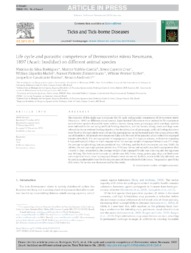Life cycle and parasitic competence of Dermacentor nitens Neumann, 1897 (Acari: ixodidae) on different animal species.
Life cycle and parasitic competence of Dermacentor nitens Neumann, 1897 (Acari: ixodidae) on different animal species.
Author(s): RODRIGUES, V. da S.; GARCIA, M. V.; CRUZ, B. C.; MACIEL, W. G.; ZIMMERMANN, N. P.; KOLLER, W. W.; BARROS, J. C.; ANDREOTTI, R.
Summary: The objective of this study was to evaluate the life cycle and parasitic competence of Dermacentor nitens(Neumann, 1897) on different animal species. Experimental infestations were induced in five specimenseach of seven species of possible hosts: rabbits, horses, sheep, cows, guinea pigs, birds and dogs. Rabbitswere infested in the ear using artificial feeding chambers, and the horses, sheep, cows and dogs wereinfested in the ear without feeding chambers. For the infestation of guinea pigs, artificial feeding chamberswere fixed on the back. Birds were infested by placing larvae on the back and under the wings without theuse of chambers. All animals were inspected daily until the end of the parasitic phase (when the engorgedfemales detached). The average period of engorgement was 25.1 days on a horse, with larvae requiring8 days and nymphs 9 days to reach engorgement; the average weight of engorged females was 271.4 mg;the average weight of egg batches produced was 159.3 mg, and the feed conversion rate was 56.8%. Onrabbits, the average engorgement period was 27.6 days, larvae and nymphs reached engorgement after7.4 and 11 days, respectively, the average weight of an engorged female was 108.4 mg and the egg masswas 30.6 mg. The feed conversion rate on rabbits was 30%. Cows, sheep, guinea pigs, dogs and birds werenot competent hosts, since no engorged females were recovered. Rabbits, when artificially infested, canbe used as an alternative host for the maintenance of these ticks in the laboratory. The parasitic specificityof D. nitens for horses was demonstrated in this study.
Publication year: 2017
Types of publication: Journal article
Unit: Embrapa Beef Cattle
Keywords: Anocentor Nitens, Artificial infestation, Hosts, Ticks
Observation
Some of Embrapa's publications are published as ePub files. To read them, use or download one of the following free software options to your computer or mobile device. Android: Google Play Books; IOS: iBooks; Windows and Linux: Calibre.
Access other publications
Access the Agricultural Research Database (BDPA) to consult Embrapa's full library collection and records.
Visit Embrapa Bookstore to purchase books and other publications sold by Embrapa.

